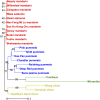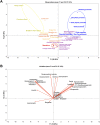The Distribution of Coumarins and Furanocoumarins in Citrus Species Closely Matches Citrus Phylogeny and Reflects the Organization of Biosynthetic Pathways
- PMID: 26558757
- PMCID: PMC4641707
- DOI: 10.1371/journal.pone.0142757
The Distribution of Coumarins and Furanocoumarins in Citrus Species Closely Matches Citrus Phylogeny and Reflects the Organization of Biosynthetic Pathways
Abstract
Citrus plants are able to produce defense compounds such as coumarins and furanocoumarins to cope with herbivorous insects and pathogens. In humans, these chemical compounds are strong photosensitizers and can interact with medications, leading to the "grapefruit juice effect". Removing coumarins and furanocoumarins from food and cosmetics imply additional costs and might alter product quality. Thus, the selection of Citrus cultivars displaying low coumarin and furanocoumarin contents constitutes a valuable alternative. In this study, we performed ultra-performance liquid chromatography coupled with mass spectrometry analyses to determine the contents of these compounds within the peel and the pulp of 61 Citrus species representative of the genetic diversity all Citrus. Generally, Citrus peel contains larger diversity and higher concentrations of coumarin/furanocoumarin than the pulp of the same fruits. According to the chemotypes found in the peel, Citrus species can be separated into 4 groups that correspond to the 4 ancestral taxa (pummelos, mandarins, citrons and papedas) and extended with their respective secondary species descendants. Three of the 4 ancestral taxa (pummelos, citrons and papedas) synthesize high amounts of these compounds, whereas mandarins appear practically devoid of them. Additionally, all ancestral taxa and their hybrids are logically organized according to the coumarin and furanocoumarin pathways described in the literature. This organization allows hypotheses to be drawn regarding the biosynthetic origin of compounds for which the biogenesis remains unresolved. Determining coumarin and furanocoumarin contents is also helpful for hypothesizing the origin of Citrus species for which the phylogeny is presently not firmly established. Finally, this work also notes favorable hybridization schemes that will lead to low coumarin and furanocoumarin contents, and we propose to select mandarins and Ichang papeda as Citrus varieties for use in creating species devoid of these toxic compounds in future breeding programs.
Conflict of interest statement
Figures








Similar articles
-
Coumarin and furanocoumarin quantitation in citrus peel via ultraperformance liquid chromatography coupled with mass spectrometry (UPLC-MS).J Agric Food Chem. 2013 Nov 13;61(45):10677-84. doi: 10.1021/jf402763t. Epub 2013 Oct 29. J Agric Food Chem. 2013. PMID: 24117278
-
Authentication of Citrus spp. Cold-Pressed Essential Oils by Their Oxygenated Heterocyclic Components.Molecules. 2022 Sep 23;27(19):6277. doi: 10.3390/molecules27196277. Molecules. 2022. PMID: 36234812 Free PMC article.
-
Content evaluation of 4 furanocoumarin monomers in various citrus germplasms.Food Chem. 2015 Nov 15;187:75-81. doi: 10.1016/j.foodchem.2015.04.007. Epub 2015 Apr 8. Food Chem. 2015. PMID: 25977000
-
[Synthesis of Furanocoumarin, Benzofuran and Coumarin Derivatives Possessing an Inhibitory Effect on Human CYP, and Elucidation of the Inhibitory Mechanism].Yakugaku Zasshi. 2017;137(10):1209-1214. doi: 10.1248/yakushi.17-00135. Yakugaku Zasshi. 2017. PMID: 28966261 Review. Japanese.
-
Chemistry and health effects of furanocoumarins in grapefruit.J Food Drug Anal. 2017 Jan;25(1):71-83. doi: 10.1016/j.jfda.2016.11.008. Epub 2016 Dec 6. J Food Drug Anal. 2017. PMID: 28911545 Free PMC article. Review.
Cited by
-
Strategies to Produce Grapefruit-Like Citrus Varieties With a Low Furanocoumarin Content and Distinctive Flavonoid Profiles.Front Plant Sci. 2021 Feb 24;12:640512. doi: 10.3389/fpls.2021.640512. eCollection 2021. Front Plant Sci. 2021. PMID: 33719319 Free PMC article.
-
Preferential Disomic Segregation and C. micrantha/C. medica Interspecific Recombination in Tetraploid 'Giant Key' Lime; Outlook for Triploid Lime Breeding.Front Plant Sci. 2020 Jun 25;11:939. doi: 10.3389/fpls.2020.00939. eCollection 2020. Front Plant Sci. 2020. PMID: 32670332 Free PMC article.
-
Retrieval of High Added Value Natural Bioactive Coumarins from Mandarin Juice-Making Industrial Byproduct.Molecules. 2021 Dec 12;26(24):7527. doi: 10.3390/molecules26247527. Molecules. 2021. PMID: 34946609 Free PMC article.
-
Safety and efficacy of a feed additive consisting of an aqueous extract of Citrus limon (L.) Osbeck (lemon extract) for use in all animal species (Nor-Feed SAS).EFSA J. 2021 Nov 8;19(11):e06893. doi: 10.2903/j.efsa.2021.6893. eCollection 2021 Nov. EFSA J. 2021. PMID: 34765034 Free PMC article.
-
Citrus × Clementina Hort. Juice Enriched with Its By-Products (Peels and Leaves): Chemical Composition, In Vitro Bioactivity, and Impact of Processing.Antioxidants (Basel). 2020 Apr 3;9(4):298. doi: 10.3390/antiox9040298. Antioxidants (Basel). 2020. PMID: 32260119 Free PMC article.
References
-
- Praloran J-C. Citrus. Paris: G.P. Maisonneuve et Larose; 1971.
-
- Gmitter FG, Chen C, Rao MN, Soneji JR. Citrus Fruits In: Kole C, editor. Fruits and Nuts. Springer; Berlin Heidelberg; 2007. pp. 265–279. Available: http://link.springer.com.bases-doc.univ-lorraine.fr/chapter/10.1007/978-.... - DOI
-
- Nelson DR. Cytochrome P450 homepage [Internet]. 2015 [cited 27 Apr 2015]. Available: http://drnelson.uthsc.edu/CytochromeP450.html.
-
- Swingle W, Reece P. The botany of Citrus and its wild relatives In: Reuther W, Webber H, Batchelor L, editors. The citrus industry. Berkeley, CA: University of California; 1967. pp. 190–430.
MeSH terms
Substances
LinkOut - more resources
Full Text Sources
Other Literature Sources

